Related Research Articles

Sierra Leone, officially the Republic of Sierra Leone, is a country on the southwest coast of West Africa. It shares its southeastern border with Liberia and is bordered by Guinea to the north. With a land area of 71,740 km2 (27,699 sq mi), Sierra Leone has a tropical climate and with a variety of environments ranging from savannas to rainforests. According to the 2015 census, Sierra Leone has a population of 7,092,113, with Freetown serving as both the capital and largest city. The country is divided into five administrative regions, which are further subdivided into 16 districts.
Sierra Leone first became inhabited by indigenous African peoples at least 2,500 years ago. The Limba were the first tribe known to inhabit Sierra Leone. The dense tropical rainforest partially isolated the region from other West African cultures, and it became a refuge for peoples escaping violence and jihads. Sierra Leone was named by Portuguese explorer Pedro de Sintra, who mapped the region in 1462. The Freetown estuary provided a good natural harbour for ships to shelter and replenish drinking water, and gained more international attention as coastal and trans-Atlantic trade supplanted trans-Saharan trade.
Temne is a language of the Mel branch of the Niger–Congo language family. Temne speakers live mostly in the Northern Province and Western Area, Sierra Leone. Temne people can be found in a number of other West African countries as well, including Guinea and The Gambia. Some Temnes have also migrated beyond West Africa seeking educational and professional opportunities, especially in Great Britain, the United States, and Egypt.
The Sierra Leone Company was the corporate body involved in founding the second British colony in Africa on 11 March 1792 through the resettlement of Black Loyalists who had initially been settled in Nova Scotia after the American Revolutionary War. The company came about because of the work of the ardent abolitionists Granville Sharp, Thomas Clarkson, Henry Thornton, and Thomas's brother John Clarkson, who is considered one of the founding fathers of Sierra Leone. The company was the successor to the St. George Bay Company, a corporate body established in 1790 that re-established Granville Town in 1791 for the 60 remaining Old Settlers.

The Limba people are an ethnic group in Sierra Leone. They represent 12.4% of the total population, making them the third largest ethnic group in Sierra Leone. The Limba are based in the north of the country across seven provinces, but are predominantly found in the Northern Province of Sierra Leone.
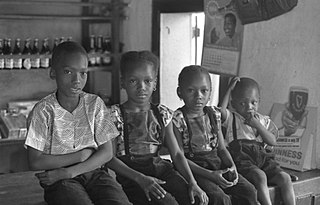
The Temne, also called Atemne, Témené, Temné, Téminè, Temeni, Thaimne, Themne, Thimni, Timené, Timné, Timmani, or Timni, are a West African ethnic group, They are predominantly found in the Northern Province of Sierra Leone. Some Temne are also found in Guinea. The Temne constitute the largest ethnic group in Sierra Leone, at 35.5% of the total population, which is slightly bigger than the Mende people at 31.2%. They speak Temne, a Mel branch of the Niger–Congo languages.

Port Loko District is a district in the North West Province of Sierra Leone. It is the most populous district in the North and the second most populous district in Sierra Leone, after Western Area Urban District. As of the 2015 census, Port Loko District has a population of 614,063. The district capital is the town of Port Loko and its largest city is Lunsar. The other major towns in the district include Masiaka, Rokupr, Pepel, Lungi and Gbinti.
The Kingdom of Kquoja or Koya or Koya Temne, or the Temne Kingdom (1505–1896), was a pre-colonial African state in the north of present-day Sierra Leone.
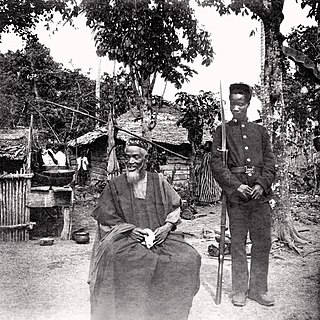
Bai Bureh was a Sierra Leonean ruler, military strategist, and Muslim cleric, who led the Temne and Loko uprising against British rule in 1898 in Northern Sierra Leone.

The Hut Tax War of 1898 was a resistance in the newly annexed Protectorate of Sierra Leone to a new tax imposed by the colonial governor. The British had established the Protectorate to demonstrate their dominion over the territory to other European powers following the Berlin Conference of 1884–1885. The tax constituted a major burden on residents of the Protectorate; 24 indigenous chiefs had signed a petition against it, explaining its adverse effects on their societies, to no avail. The immediate catalyst for hostilities was an attempt by British colonial officials to arrest the Temne chief Bai Bureh, a general and war strategist, on the basis of rumours. Although often depicted as the chief who initiated an armed resistance in the North in 1898, late 20th-century sources suggest he was unfairly identified by the colonial government as a primary instigator, with the government's hostile actions provoking the war. Later that year, resistance arose in the south by the leading Mende.
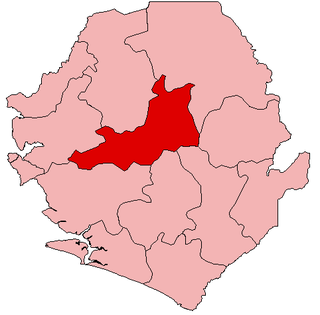
Yonibana is a small rural town in Tonkolili District in the Northern Province of Sierra Leone. It is the centre of the Yoni Chiefdom The vast majority of its population are from the Temne ethnic group and the Temne language is widely spoken in the town. Yonibana lies approximately 28.2 miles to the district capital Magburaka and approximately 90 miles north-east of Freetown.
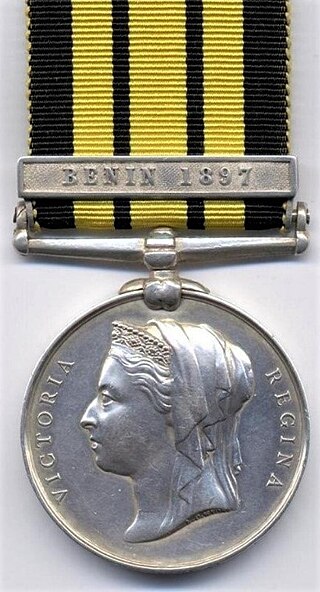
The East and West Africa Medal, established in 1892, was a campaign medal awarded for minor campaigns that took place in East and West Africa between 1887 and 1900. A total of twenty one clasps were issued.
Makari Gbanti is a chiefdom of Bombali District in the Northern Province of Sierra Leone. Officially, the principal town now lies at Masongbon. However, the village of Panlap is also considered the headquarters. The historical centre was Makari.

HMS Icarus was a Mariner-class composite screw gunvessel of 8 guns, and the third Royal Navy vessel to carry the name. She was launched in 1885 at Devonport and sold in 1904.
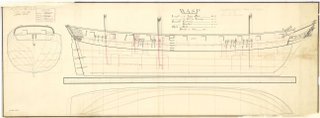
HMS Wasp was an 18-gun sloop of the British Royal Navy. She was formerly the French naval brig Guêpe, which the Navy captured in 1800. She served during the French Revolutionary and Napoleonic Wars, and was sold out of naval service in 1811.

Sierra Leone is home to about sixteen ethnic groups, each with its own language. In Sierra Leone, membership of an ethnic group often overlaps with a shared religious identity.
The Yoni Chiefdom is a Chiefdom of Sierra Leone located in Tonkolili District, Northern Province, Sierra Leone. It is centred on Yonibana and the Yoni people are part of the Temne ethnic group.
The Sierra Leone Police Corps was established in 1829, by the colonial authorities of British West Africa. Recruitment was primarily made from Sierra Leone Creole people.
Sory Kessebeh was a Loko leader in the mergent Sierra Leone protectorate during the nineteenth century. His name arose because he wore sebe traditional charms influenced by Islam.
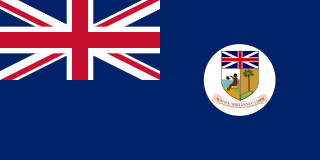
The Colony and Protectorate of Sierra Leone was the British colonial administration in Sierra Leone from 1808 to 1961, part of the British Empire from the abolitionism era until the decolonisation era. The Crown colony, which included the area surrounding Freetown, was established in 1808. The protectorate was established in 1896 and included the interior of what is today known as Sierra Leone.
References
- 1 2 "The Yoni Campaign". The Soldier's Burden. Kaiserscross. Retrieved 29 April 2016.
- ↑ Fyle, Magbaily C (2006). Historical Dictionary of Sierra Leone. Lanham Maryland: Scarecrow Press.